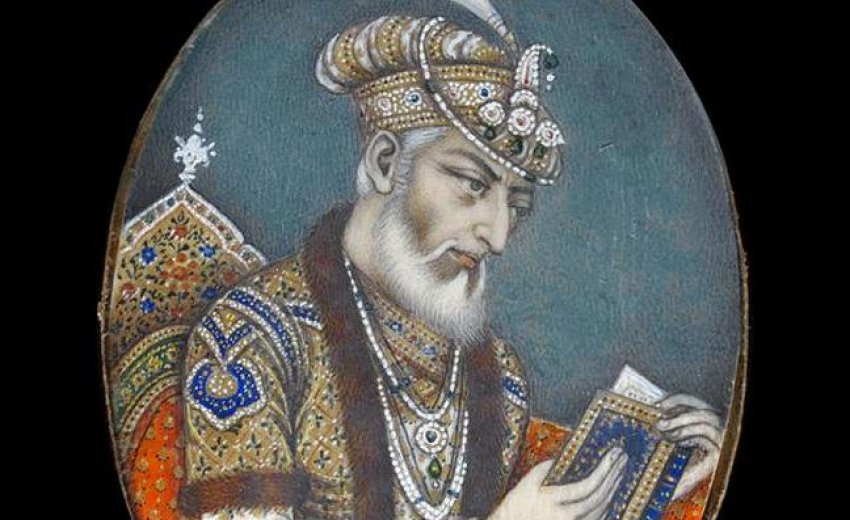As we celebrate the 350th Birth Anniversary of our revered Guru Gobind Singh Ji; an unprecedented enthusiasm is showing everywhere. Congratulations to all on this grand day of rejoicing and celebration.
On this historical day, I will share with you the evil of Aurangzeb that necessitated the need for an enlightened soul, Guru Gobind Singh, to rise to the occasion, and save the Hindus and other Non-Muslims, from forcible conversion to Islam, saving India from becoming another Islamic state. Ramayan could not have been written, and the avatar of Ram could not be glorified, had Ravan not been there. Morality is sometimes best seen through the lens of immorality. The greatness of Guru Gobind Singh can best be viewed through the barbarity of Aurangzeb, which can only be compared to Genghis Khan, Vlad Dracula, or Hitler.
Everyone may not know that the Islamic state of Afghanistan was once a Buddhist state. It had one of the largest Buddhist populations, and world’s most amazing Buddhist statues and heritage sites. Many Islamic rulers from the middle-east attacked Afghanistan between the seventh and the tenth Centuries. But, Mahmud Ghazni, the most dreadful man from Persia, invaded Afghanistan and forcibly converted the Buddhist nationals into Muslims. Those who refused had to flee the country to save their lives. He turned the Buddhist Afghanistan into an Islamic state about a millennium ago. India would have met a similar fate as well at the hands of Aurangzeb, had the wall of Guru Gobind Singh and his family not been there to protect the Hindus, Hindustan, and Hinduism.
Shahjahan, the fifth Mughal emperor, had four sons; Dara Shikoh, Shah Shuja, Aurangzeb and Murad Baksh. He had formally announced his eldest son Dara Shikoh the heir to his throne, and granted him the title of “Shahzada-e-buland-Iqbal” (The fortunate prince) which was later raised to “Shah-e-buland-Iqbal” (The King of high fortune.) As long as Shahjahan remained healthy, and kept his rule in his control, no one raised his voice against his decision. But, the deteriorating health of King Shahjahan triggered a desperate struggle for power among his four sons that led to a lot of bloodshed and cruelty. The war of succession after Shahjahan was a fierce battle waged by his four sons. But Aurangzeb, the third son, was special. He was a thinker, a strategist, and most importantly; the most ruthless and cruel among all of them.
The war of succession was a series of battles on different fronts. On the one side was the Emperor and his heir, Dara, and on the other side his other three sons. Aurangzeb was the shrewdest among all. He gained the confidence of his other two rebel brothers and made a coalition with them to fight united for the throne.
With their help, he overthrew the Emperor and imprisoned him and made Dara run away from the battle field. In the process, he cleverly eliminated both his supporting brothers as well. Later, he captured Dara and beheaded him at the Khooni Darwaza, a memorial in New Delhi. It is said that he put Dara’s severed head in a plate and presented it to his ailing father in the prison to celebrate his victory.
Aurangzeb acquired a satanic form in his later life. His cruelty crossed the limit when he forced the Hindus and the other Non-Muslim Indians to convert to Islam. This was unacceptable. But, Aurangzeb’s persecution was so severe, that people had to choose between death or converting. At that point, the Kashmiri Pandits approached Guru Gobind Sigh Ji’s father, and the ninth avatar, GuruTeg Bahadur Ji, and pleaded to save them from Aurangzeb’s atrocities. Guru Teg Bahagur Ji agreed to help them and challenged Aurangzeb that if he could convert him to Islam; he could convert the entire Hindu community. Aurangzeb agreed and tortured Guru Teg Bahadur Ji by all means to try to get him to convert; but he failed. In his frustration, he ordered Guru Teg Bahadur Ji killed and that brought forth the courageous warrior side of the Sikhs led by Guru Teg Bahadur Ji’s son, Guru Gobind Singh.
One’s situations in life may change, but his basic nature remains the same. The important point is that Aurangzeb was a liar, a cheat, and a disloyal person, who lived and died with these inherent characteristics. By making false promises to his rebel brothers, he grabbed the throne, and did not hesitate to eliminate them to save himself from any future threat. He used the same trick with Guru Gobind Singh in the battle of Anandpur in 1704. In the first attack, Aurangzeb sent his army led by Saiyad Khan and Ramjan Khan. The Mughal generals were wounded by the Sikh soldiers and the Mughal army ran from the battlefield. Then, Aurangzeb sent a much larger army led by Wazir Khan and Zabardast Khan, and played a rather different strategy. The approach of the Mughal army this time was to lay a protracted siege of Anandpur and cut-off food and other essential supplies to the city. This is considered the most unethical way of fighting a battle. It was started by the cruellest ruler in the history, Genghis Khan. Aurangzeb used it in the battle of Anandpur against Guru Gobind Singh. No wonder, for he was of the lineage of Genghis Khan, and he redefined terror in his own style.
The siege of the city went on for many months and people trapped inside the city were dying due to lack of food and essential supplies. At this point, Aurangzeb took an oath on the Koran and promised Guruji and his people a safe passage from Anandpur. In such a scenario, Guru Ji accepted Aurangzeb’s offer to save the lives of its people from hunger and disease. But, when Guruji, his family, and his army men left, Aurangzeb’s general Wazir Khan attacked them from behind and took Mata Gujri, Guru Ji’s mother, as well as his two sons captive and killed them. He chased Guru Ji and his retreating troops and caused heavy casualties. This was followed by the historical battles in Chamkaur, which marked the martyrdom of Guru Ji’s two elder sons, Sahibzada Ajit Singh and Sahibzada Jujhar Singh; and in Muktsar, which marks the martyrdom of the forty loyal Sikhs of Guru Gobind Singh (Chalis Mukte – The Forty Liberated Sikhs).
After sacrificing his entire family to the war against the evil, Guru Gobind Singh Ji wrote a defiant letter, titled ZAFARNAMA to Aurangzeb. Zafarnama means; an EPISTLE OF VICTORY. This letter is literally a reprimand by a spiritually enlightened person of the highest realm to a cruel, distorted animal residing in a human body in pitiful nether planes of existence. Guru Ji indicted Aurangzeb’s treachery through his generals and soldiers and stated that: ‘Although you appear to follow some verses of Koran, in reality, you are not God’s man. You are a devil who has no understanding of God. You are a sinner who broke his oath taken on the Koran. But, despite all your deceptions, you could not harm me; and despite all my sufferings, I have won a moral victory over you.’
Guru Ji wanted to know the immediate reaction of his letter on Aurangzeb’s face, so he sent Bhai Daya Singh and Bhai Dharam Singh to deliver the letter personally. He instructed his Sikhs to meet the Emperor fearlessly and boldly.
ZAFARNAMA pierced Aurangzeb’s heart and shook his life. His body started to tremble from the feelings of remorse and regret. Having seen the reality of his soul through Guru Gobind Singh Ji’s spiritual light, his peace of mind had been shaken, and he became ill. He wrote a letter to his sons, in which, he stated, “I do not know who I am, where I am, where I am to go, and what will happen to a sinful person like me. Many like me have passed away wasting their lives. God was in my heart, but my blind eyes could not see him. I don’t know how I will be received in God’s court, and how I will face God. I do not have any hope for my future. I have committed many sins, and do not know what punishment will be awarded to me in return.”
Guruji’s letter of victory demoralized Aurangzeb and shattered his life to pieces. He saw the truth in the form of Guru Gobind Singh, and came to realize that only Guru Ji could show him the right and truthful path through which he could wash his sins and misdeeds. He wanted to meet Guru Ji to seek redemption before his death. So, he wrote a reply to Guru Ji requesting him to visit him as he had fallen ill, and was too weak to travel, and send it back through Guru Ji’s messengers. He withdrew all orders against Guru Ji and instructed his minister Munim Khan to make arrangements for a safe passage for Guru Ji when he came to meet him.
Guru Ji received Aurangzeb’s letter and very kindly decided to meet him. Perhaps, he wanted to help the sinner in the last time of his life. But, it was not destined. Aurangzeb died in a degenerated physical and mental state before Guru Ji could reach him.
“Dharm” and “Adharm” can be seen by drawing a parallel between the lives of Guru Gobind Singh and Aurangzeb. “Dharm” lived through Guru Gobind Singh, who sacrificed the lives of his father, mother, wife, and four sons in the selfless service for humanity and mankind. “Adharm” was Aurangzeb’s way of life; he killed his father and three brothers to meet his nefarious motives. The lesson is that “Dharm” prevails, for that’s God’s command for mankind.
Over three hundred years have passed since both, Guru Gobind Singh and Aurangzeb died. What a contrast! The world loves, remembers, adores and follows Guru Gobind Singh, who lives in people’s hearts; but no one remembers Aurangzeb. Now millions from all over the world are gathering to celebrate Guru Gobind Singh Ji’s three hundred fiftieth Birth Anniversary, and Aurangzeb and his ideology remains buried in an unmarked grave in an unknown place; dead, as ever.
WAHEGURU JI KA KHALSA, WAHEGURU JI KI FATEH!






